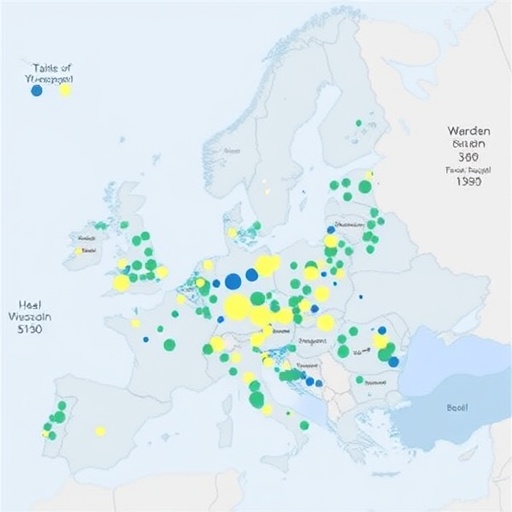In a groundbreaking study published in Nature Communications, researchers from Sweden have unveiled compelling evidence that the heritability of type 1 diabetes remains stable across generations, challenging previous assumptions about the fluctuating genetic risk of this autoimmune disease. The comprehensive nationwide cohort study meticulously analyzed data spanning several decades, encompassing a vast array of familial and genetic information, which has allowed for one of the most robust estimations of hereditary influence on type 1 diabetes to date. This work not only deepens our understanding of the genetic architecture underlying the disease but also carries significant implications for future research directions, predictive modeling, and therapeutic development.
Type 1 diabetes (T1D) is characterized by the immune-mediated destruction of insulin-producing beta cells in the pancreas, resulting in lifelong dependency on exogenous insulin. Although the environmental triggers of T1D have been intensely studied, genetic predisposition remains a cornerstone in explaining individual susceptibility. Prior studies suggested variability in heritability estimates, owing to diverse methodologies and population heterogeneity. Wei, Andersson, Liu, and colleagues aimed to overcome these limitations by leveraging Sweden’s comprehensive national health registers, which provide an unparalleled resource for longitudinal familial disease tracking and genetic linkage analysis.
The researchers’ methodological framework involved constructing a nationwide cohort encompassing individuals born over multiple decades and their relatives, including siblings, parents, and extended family members. Utilizing rigorous epidemiological and statistical models, the team quantified heritability by partitioning phenotypic variance into genetic and environmental components, applying state-of-the-art kinship-based heritability estimation methods. By controlling for confounding factors such as diagnostic improvements and environmental shifts, the study provides a refined, temporally stable heritability estimate that sheds light on the enduring role of genetics in T1D susceptibility.
.adsslot_lD61iUOuZ2{width:728px !important;height:90px !important;}
@media(max-width:1199px){ .adsslot_lD61iUOuZ2{width:468px !important;height:60px !important;}
}
@media(max-width:767px){ .adsslot_lD61iUOuZ2{width:320px !important;height:50px !important;}
}
ADVERTISEMENT
The study’s results reveal that the heritability of type 1 diabetes remains remarkably consistent across birth cohorts, maintaining a level that underscores the persistent impact of genetic predisposition despite changes in environmental exposures. This counters certain hypotheses that environmental factors might be diluting the apparent genetic signal over time, an idea that had received some traction due to rising T1D incidence globally. Instead, the evidence supports the notion that genetic susceptibility is a stable property in the population, suggesting that the observed increases in incidence are likely driven by environmental triggers acting on a genetically predisposed substrate.
Intriguingly, the study highlights the complex interplay between genetic risk loci with varying effect sizes, predominately concentrating on highly penetrant HLA (human leukocyte antigen) haplotypes known to confer significant T1D risk. However, the investigators emphasized that the contribution of non-HLA genetic variants remains consistent, corroborating the polygenic nature of the disease. The comprehensive genetic snapshot captured in this Swedish cohort thus reconfirms that while HLA genes harbor a substantial proportion of heritable risk, the cumulative effect of numerous other genetic factors cannot be underestimated.
From a mechanistic perspective, these findings have important ramifications. Stable heritability suggests that genetic markers identified in current genome-wide association studies (GWAS) are likely to remain relevant predictors of T1D risk in future populations. This supports ongoing efforts to integrate genetic profiles into personalized medicine frameworks, enabling predictive risk stratification and potentially preemptive interventions. Moreover, the constancy of genetic influence provides a rationale for sustained investment in exploring gene-environment interactions, since identifying modifiable environmental components acting on a fixed genetic backdrop could unlock novel prevention strategies.
The Swedish cohort’s unique scale and completeness allowed the researchers to explore heritability in various subpopulations, including stratification by age of onset and familial relationship type. Interestingly, the stability in heritability estimates was observed both in early-onset and later-onset T1D cases, suggesting that genetic risk factors exert influence across the disease’s temporal spectrum. This finding challenges the previously held notion that late-onset T1D might be more environmentally driven, reframing our understanding of disease etiology.
Of particular note is the study’s demonstration that heritability estimates derived from population-based data align closely with those from twin studies, long considered the gold standard in genetic epidemiology. This corroboration validates the use of large-scale register data as a powerful alternative to twin registries, especially in contexts where twins are scarce or data collection is challenging. Consequently, this methodological approach paves the way for similar heritability studies of other complex diseases using national health databases around the world.
The implications for clinical practice are multifaceted. With stable heritability estimates reinforcing the centrality of genetic risk, genetic counseling gains enhanced significance for families affected by T1D. Potential carriers of high-risk genotypes could benefit from tailored monitoring regimes and lifestyle recommendations aimed at mitigating environmental triggers. Also, in the realm of clinical trials, genetically stratified cohorts might improve the precision and efficacy assessment of novel immunomodulatory therapies, potentially accelerating the path toward T1D prevention and cure.
Furthermore, the study’s results comment indirectly on public health policy. As T1D incidence continues to rise globally, especially in younger populations, understanding that genetic predisposition remains constant implies that environmental factors—possibly changes in microbiome, childhood infections, diet, or exposure to pollutants—deserve intensified investigation and intervention. Policy frameworks emphasizing early-life environmental health could have a profound impact if such modifiable risks are confirmed as critical disease initiators atop a genetically stable foundation.
The authors acknowledge certain limitations inherent in their study, including dependence on diagnostic accuracy in register data and potential unmeasured environmental confounders. Nonetheless, their rigorous statistical controls and the robustness of the Swedish health system’s data quality greatly mitigate these concerns. Future research integrating detailed genetic sequencing with environmental exposure profiling promises to unravel the finer nuances of disease susceptibility and pathogenesis.
This landmark study heralds a pivotal advance in the field of autoimmune diabetes research, demonstrating the power of large-scale, longitudinal, population-based datasets to resolve longstanding questions regarding the genetic versus environmental contributions to disease. The principle of stable heritability established herein provides a sturdy framework upon which future explorations of T1D etiology can reliably build, promising novel avenues for prevention, diagnosis, and treatment.
In sum, Wei and colleagues have furnished the scientific community with a precise, comprehensive evaluation of type 1 diabetes heritability, underscoring its enduring and stable role across generations within the Swedish population. Their work not only challenges prior contentions of shifting genetic influence but also solidifies the foundation for integrated genetic and environmental research paradigms. As the quest for a cure for type 1 diabetes continues, such insights are invaluable in guiding both basic science and clinical innovation toward effective, personalized solutions.
The reverberations of this discovery extend beyond T1D alone, highlighting the potential of national health registries as treasure troves for genetic epidemiology of various complex diseases, particularly those with elusive multi-factorial etiologies. As countries invest in digital health infrastructures, the ability to dissect heritability patterns with precision will become a cornerstone of modern medical research and public health planning.
In conclusion, this Swedish nationwide cohort study not only refines our understanding of the genetic underpinnings of type 1 diabetes but also elegantly contextualizes the interplay of genetics and environment in autoimmune disease etiology. With stable heritability as a cornerstone, the future of diabetes research and clinical management looks poised for transformative progress that capitalizes on the convergence of genetics, epidemiology, and precision medicine.
Subject of Research: Stability of genetic heritability in type 1 diabetes over multiple generations in a Swedish nationwide cohort.
Article Title: Stable heritability of type 1 diabetes in a Swedish Nationwide Cohort Study
Article References:
Wei, Y., Andersson, T., Liu, S. et al. Stable heritability of type 1 diabetes in a Swedish Nationwide Cohort Study. Nat Commun 16, 5327 (2025). https://doi.org/10.1038/s41467-025-60813-2
Image Credits: AI Generated
Tags: autoimmune disease heritabilityenvironmental triggers of type 1 diabetesfamilial and genetic information type 1 diabetesgenetic architecture of type 1 diabetesgenetic risk factors for type 1 diabetesimmune-mediated destruction beta cellsimplications for future diabetes researchlongitudinal tracking of type 1 diabetesnationwide cohort study Swedenpredictive modeling for diabetes researchstable heritability of type 1 diabetestherapeutic development for type 1 diabetes





